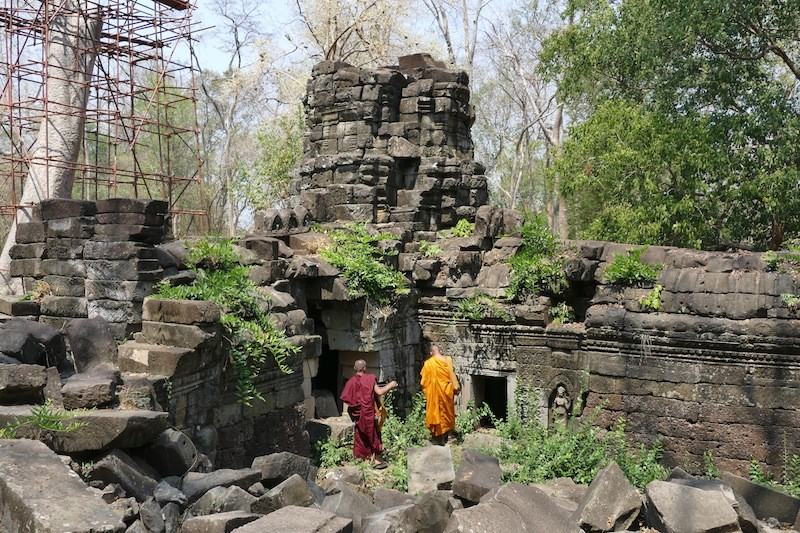Over the centuries, looting, theft and mismanagement have plagued the 12th century Banteay Chhmar temple complex in Banteay Meanchey province. But the sprawling Angkorian monument is about to get a second life as an international training ground for future archaeologists and monument restoration specialists.
After an initial agreement was signed in December, the Ministry of Culture and the University of London’s School of Oriental and African Studies (SOAS) are now hammering out details to set up a field school for post-graduate students—many of them from Southeast Asia—and young Cambodian professionals.

“The overarching aims are to work with established Cambodian experts in the field to train the next generation of heritage managers with the necessary practical and critical skills to lead heritage work in the Southeast Asian region,” Ashley Thompson, head of SOAS’ Center of South East Asian Studies, said in an email interview.
While funding still is being sorted out, the plan is to launch the program toward the end of the year. The project will also include the restoration of Ta Nem, one of the monument’s satellite temples adjacent to the main complex.
“Thanks to the decades of international collaboration at Angkor in particular, Cambodian expertise is now region-leading, and in some areas, world-leading,” Ms. Thompson said, referring to the numerous projects in Angkor Archeological Park, where Cambodians have worked alongside international experts for more than two decades.
“We recognize this and have designed a project which avoids placing an international expert at the head of conservation but rather supports Cambodian national expertise in assuming responsibility,” she said.
Near the end of the 12th century, the modest Banteay Chhmar site had been transformed into one of the largest monastery complexes in the country, spreading over 12 km and including eight secondary temples.
Its remote location in idyllic countryside about 20 kilometers from the Thai border, however, has exposed it to theft in recent years. In 1998, it was victim of a spectacular looting operation when 30 meters of wall adorned with sculpted features was chopped off and smuggled into Thailand. A portion of the wall was later seized by the Thai authorities and returned to Cambodia while another section disappeared—according to several sources, it is at the home of a prominent Thai businessman near Bangkok.
Also due to its remote location, the monument had never been restored. Though Banteay Chhmar was known and documented by the French as far back as the late 19th century, archeologists and architects who had embarked on the restoration of Angkor a century ago focused on monuments in Siem Reap province. And when international and Cambodian teams began new restorations in the 1990s and early 2000s, that was where the attention remained.
The new plan to restore Banteay Chhmar follows a restoration project that fell apart itself, necessitating the intervention of the Ministry of Culture. In 2008, the Global Heritage Fund (GHF) began an eagerly anticipated restoration effort at Banteay Chhmar, only to see the repeated absence of the man in charge, British architect John Sanday, according to several people close to the project.
It was only due to the direct intervention of the Culture Ministry, which sent Kim Sothin—a restoration expert and director of the Department for Safeguarding and Preservation of Ancient Buildings—that some of the planned work was accomplished.
In the end, emergency measures were taken to consolidate some structures that were close to collapsing. A wall with elaborate sculpted scenes of historical importance was rebuilt with support from the organization Friends of Khmer Culture, which provided funding to help study and reconstruct the scenes.
Mr. Sanday did not reply to emailed requests for comment. Cathy Giangrande, director of GHF United Kingdom, said that the project had been a success.
Mr. Sothin said the project had allowed the ministry to detail what further restoration was needed. Approximately 80 features need intervention; 29 of them urgently, he said.
For a visitor, walking inside Banteay Chhmar is magical. Surrounded by gray stones and green foliage, one feels something like a 19th century explorer discovering a kingdom in the middle of the jungle.
The monument is an example of what French archeologists of a century ago faced when they embarked on Angkor’s restoration—that is, the gigantic task of clearing moss and foliage to see what needed to be done, said French researcher Olivier Cunin. This clearing work must be done painstakingly so as not to weaken stone structures now supported by roots and trees, explaining why restoring a monument takes more years than it took to build, he said.
One reason for investing time and energy into Banteay Chhmar is because of its historical importance, said Mr. Cunin, who has been studying the monument for years.
Toward the end of the 13th century, images of the Buddha in Jayavarman VII’s monuments were replaced by images of Shiva.
“At Banteay Chhmar, this iconoclast reaction did not take place,” he said. “Therefore, you have the original Buddhist iconography,” which makes the monument the more interesting for historical research, he added.
This is one of the reasons why those walls with sculpted scenes are to be included in the SOAS conservation project, said Joanna Wolfartht, the school’s Banteay Chhmar Project Coordinator. GHF also plans to contribute to the project, she said.
One other characteristic makes this monument unique, Mr. Cunin said. One princely figure standing near the king in a scene sculpted on the wall of Banteay Chhmar does not appear in a similar scene at the Bayon, the monument built at the center of Jayavarman VII’s capital during the same period, he said.
“There must have been political events in the meantime for this personage shown [at Banteay Chhmar]…not to appear in the same scene at the Bayon.”
This discrepancy makes him believe “that the scenes sculpted on the walls of Banteay Chhmar were prototypes for those that would later be done at the Bayon temple.”